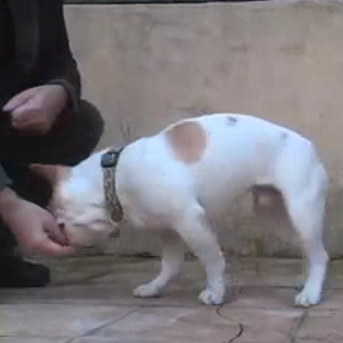Overview
Teaching your dog to stand is helpful for wiping paws after a muddy walk, clipping nails, and during vet exams. Plus, knowing at least three commands allows you to mix them up during training. If you just alternate between ‘sit’ and ‘down,’ your puppy may not really learn the cues—he’ll just assume, if he’s sitting, that you want him to lie down, and vice versa.
Steps to teaching “stand”
- Find a quiet spot free of distractions.
- Ask your puppy to sit.
- Hold a food treat near your puppy’s nose, say “stand,” and slowly bring your hand directly forward and slightly down. Your pup’s nose should either point straight out or move slightly lower—never higher.
- Encourage your pup to move forward by quietly patting your leg or making kissing noises.
- As soon as your pup’s bottom is off of the floor, lower your hand with the treat just a bit more, so it’s even with his chest, and ever so slightly push your hand towards his chest so that his chin drops and his nose is pointing towards the floor.
- When your pup’s standing squarely, say “Yes!” and give him a treat.
- Repeat several times. Once your puppy seems to have the hang of it, practice starting from a ‘down’ position.
- Gradually make it more challenging by adding, one at a time, the three D’s: duration, distance, and distraction. First, duration: each time your pooch stands on command, on the next try add one second to the delay between when your puppy stands and when you deliver the reward. Then, distance: stand one step further away from your puppy each time you give the command. Finally, add in distractions, such as a bouncing ball or another dog in the area.
- Go slowly when adding challenges, and if your puppy ever goofs, go back a step until he’s getting it right again.
DogTime tip: Keep your praise steady and calm, rather than high-pitched and excited. If you get too bubbly, your puppy may go into a wigglefest instead of standing squarely.
Troubleshooting
Your puppy immediately lowers himself into a sit:
This is common; since ‘sit’ is often the first position taught, it becomes the default position when your puppy’s not sure what you want. Make sure you’re not raising your hand at all—many people do so without realizing it. If you need to, put your arm or leg right in front of your pup’s back legs so he can’t sit down.
If you can get your puppy to stand for a second, quickly reward him with a treat, then press lightly on his back, at the shoulder blades. He’ll brace to meet the pressure, which keeps him in the standing position.









